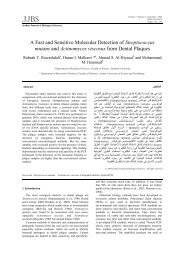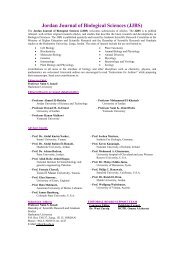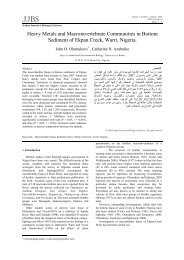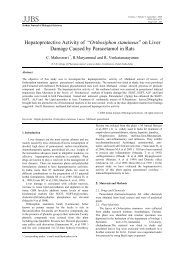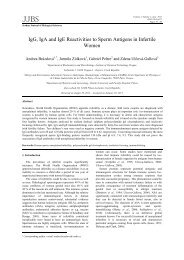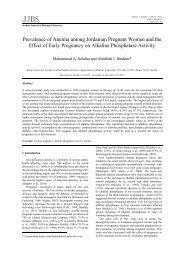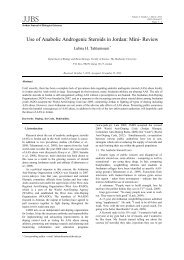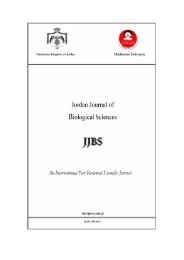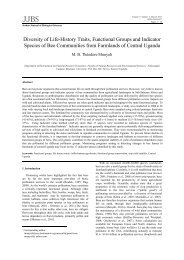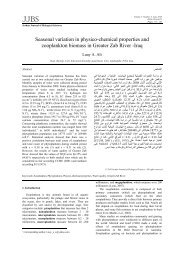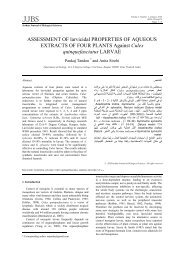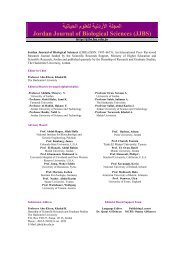Mohammed Shahow M. Ghafoor - Jordan Journal of Biological ...
Mohammed Shahow M. Ghafoor - Jordan Journal of Biological ...
Mohammed Shahow M. Ghafoor - Jordan Journal of Biological ...
You also want an ePaper? Increase the reach of your titles
YUMPU automatically turns print PDFs into web optimized ePapers that Google loves.
JJBS<br />
<strong>Jordan</strong> <strong>Journal</strong> <strong>of</strong> <strong>Biological</strong> Sciences<br />
Volume 4, Number 3, September 2011<br />
ISSN 1995-6673<br />
Pages 173 - 176<br />
Determination <strong>of</strong> Larval Instars <strong>of</strong> Black Cutworm Agrotis ipsilon<br />
(Hufnagel) (Lepidoptera, Noctuidae)<br />
Abstract<br />
<strong>Mohammed</strong> <strong>Shahow</strong> M. <strong>Ghafoor</strong><br />
Horticulture Department, College <strong>of</strong> Agriculture, Sulaimani University, Iraq<br />
Received 26 March, 2011; received in revised form 17 May 2011; accepted 22 May 2011<br />
The numbers <strong>of</strong> larval instars <strong>of</strong> Agrotis ipsilon (Hufnagel) were determined using measurements <strong>of</strong> larval head-capsule<br />
width. The obtained results emphasized that the head capsule width recorded was 0.28 mm for the 1 st instar (newly hatched<br />
larvae) and 3.42 mm for the 6 th instar (taken to pupation). The overall results fit in with Dyar's rule.<br />
Keywords: Agrotis ipsilon, head-capsule width, larval instars, Dyar’s Rule, number <strong>of</strong> instars.<br />
1. Introduction *<br />
The larvae <strong>of</strong> Agrotis ipsilon (Hufnagel) (Lepidoptera,<br />
Noctuidae) is more commonly known as the black or<br />
greasy cutworm. It is a polyphagous serious pest <strong>of</strong><br />
different economic plants found throughout the world<br />
(Rings and Johnson, 1975; El-Salamouny et al., 2003).<br />
Moreover, it is a serious pest <strong>of</strong> golf courses as well as<br />
vegetables and field corps (Hong and Williamson, 2004).<br />
The feeding habits vary across the six larval instars (Allan,<br />
1975; Clement and McCartney, 1982).<br />
There are several studies that apply Dyar's rule to other<br />
insect species. According to Dyar's rule, which is used for<br />
determining the instars and stages <strong>of</strong> many insect species,<br />
Moser et al. (1991) found that the width <strong>of</strong> the head<br />
capsules <strong>of</strong> Ctenocephalides felis (Bouche) <strong>of</strong> different<br />
instars had geometrically progressing growth. Goldson et<br />
al. (2001) found larval instar's distribution <strong>of</strong> the<br />
Argentina stem weevil by using head capsule width.<br />
Lauzon and Harper (1993) followed the growth <strong>of</strong> aquatic<br />
snipe fly, Atherix lantha Webb (Diptera, Athericidae),<br />
depending on measurements <strong>of</strong> second antennal segment<br />
<strong>of</strong> the larvae.<br />
Rodriguez-Loeches and Barro (2008) found that the<br />
measurement <strong>of</strong> head capsule <strong>of</strong> Phoenicoprocta<br />
capistrata (Lepidoptera, Arctiidae) larvae followed a<br />
geometric pattern consistent with Dyar's rule. Moreover,<br />
Shashi and Singh (2009) determined the exact nymphal<br />
stages <strong>of</strong> Chrotogonus trachypteras (Blanchard).<br />
In the present study, it was attempted to find out the<br />
number <strong>of</strong> larval instars depending on the measurement <strong>of</strong><br />
larval head capsule width, and applying Dyar’s rule to the<br />
results.<br />
* Corresponding author: shahow52@yahoo.com<br />
© 2011 <strong>Jordan</strong> <strong>Journal</strong> <strong>of</strong> <strong>Biological</strong> Sciences. All rights reserved<br />
2. Material and Method<br />
By using light traps, the moths were caught then placed<br />
in plastic boxes. They were fed with 10% honey water.<br />
The collection <strong>of</strong> eggs was facilitated by muslin cloth. The<br />
eggs were placed in an incubator (25°C) to hatch. The<br />
larvae were separated by plastic grids to form individual<br />
chambers and were kept at 25°C, 60-70% relative<br />
humidity. The larvae were reared on an artificial diet<br />
(Oxford recipe). The diet consisted <strong>of</strong> caseine, wheat<br />
germ, dry yeast, cholesterol, agar, wessons salt, vitamins<br />
and antibiotics mixture, fungicide and water (Hansen and<br />
Zethner, 1979). The experiment started with<br />
approximately 1000 newly hatched larvae which were<br />
reared as discussed above. Widths <strong>of</strong> larval head capsules<br />
were measured to determine the larval instars according to<br />
Dyar’s rule (Gullan and Cranston, 2005).<br />
The width <strong>of</strong> the head capsule <strong>of</strong> each larva was<br />
measured using a calibrated ocular micrometer in a<br />
binocular dissecting microscope. For each instar, 100<br />
larvae were randomly selected and their head capsules<br />
measured in interval periods. The rest were kept rearing<br />
on the diet until the last instar measurement <strong>of</strong> head<br />
capsule took place. Since it was difficult to measure a live<br />
larval head capsule, 70% alcohol was used to kill the<br />
larvae before measuring the head capsule. The larvae<br />
which were deemed to be in their final instar were not<br />
killed; instead, their head capsule was measured while they<br />
were alive. They were then kept until pupation to ensure<br />
that further molting did not occur.<br />
3. Results and Discussion<br />
The figures obtained from measuring the head capsule<br />
width were plotted on diagram paper against the number <strong>of</strong><br />
larvae. In this way, a histogram (Figure 1) was produced,<br />
with six different groups <strong>of</strong> larvae.
Figure 1: The measurement <strong>of</strong> larval head capsule width plotted against the number <strong>of</strong> larvae producing 6 different groups<br />
174<br />
Width <strong>of</strong> Larval Head capsules (mm)<br />
© 2011<strong>Jordan</strong> <strong>Journal</strong> <strong>of</strong> <strong>Biological</strong> Sciences. All rights reserved - Volume 4, Number 3
© 2011<strong>Jordan</strong> <strong>Journal</strong> <strong>of</strong> <strong>Biological</strong> Sciences. All rights reserved - Volume 4, Number 3 175<br />
The 1 st group included only newly hatched larvae<br />
which were consequently representative <strong>of</strong> the 1 st stage<br />
instar. On the other hand, the 6 th group included the larvae<br />
which were pupated without further molting, so it is<br />
regarded as the final instars.<br />
For many population studies, it is important to know<br />
the number <strong>of</strong> larval or nymphet instars within a species in<br />
order to be able to recognize the instars to which any<br />
immature individual belongs. More frequently, the only<br />
obvious difference between successive larval or nymphal<br />
instars is the increase in size that occurs after each molt.<br />
Thus, it should be possible to determine the actual number<br />
<strong>of</strong> instars in the life history <strong>of</strong> a species from a frequency<br />
histogram <strong>of</strong> the measurements <strong>of</strong> a sclerotized body part<br />
such as the width <strong>of</strong> the head capsule or the length <strong>of</strong> the<br />
mandible. Dyar's rule developed from his observation <strong>of</strong><br />
the measurement <strong>of</strong> the larval head capsule width <strong>of</strong> some<br />
Lepidoptera species (Gullan and Cranston, 2005). Dyar's<br />
rule states that if the logarithms <strong>of</strong> the measurements <strong>of</strong><br />
some sclerotized body part in different instars is plotted<br />
against the instars number, a straight line should result;<br />
any deviation from a straight line indicates a missing<br />
instars. In figure 2, one can notice that a straight line is<br />
produced, which indicates that there is no missing instars,<br />
fitting in with Dyar's rule. In figures 1 and 2 along with<br />
Table 1, we can see that there are six larval instars <strong>of</strong> A.<br />
ipsilon. These results agree with Zaz (1999), and Alnaji<br />
and <strong>Ghafoor</strong> (1988) who found that the larvae have six<br />
instars. On the other hand, Luckman et al. (1976) reported<br />
that larvae have seven instars. But Allan (1975) stated that<br />
the black cutworm has five instars only.<br />
Figure 2. A linear regression shows a straight line which fitted with Dyar’s rule
176<br />
Acknowledgment<br />
© 2011<strong>Jordan</strong> <strong>Journal</strong> <strong>of</strong> <strong>Biological</strong> Sciences. All rights reserved - Volume 4, Number 3<br />
Table 1. Mean measurements width (mm) <strong>of</strong> larval head capsules <strong>of</strong> the Agrotis ipsilon<br />
Larval instars No. <strong>of</strong> larvae Average <strong>of</strong> head capsule width (mm)± S.E<br />
1 st 100 0.307±0.0015<br />
2 nd 100 0.4726±0.0030<br />
3 rd 102 0.681±0.056<br />
4 th 108 1.16129±0.009<br />
5 th 98 1.96816±0.012<br />
6 th 117 2.95982±0.012<br />
I would like to thank Dr Abdulsalam Abdulrahman<br />
Rasool and Dr Nawroz A.Tahir <strong>of</strong> Field Crop Department<br />
as well as Mr Salam M Sliman <strong>of</strong> Horticulture Department<br />
for their cooperation during working on this study.<br />
References<br />
Allan DI. 1975. Greasy cutworm, Agrotis ipsilon (Hufnagle), life–<br />
cycle. DSIR information series No.105/11 New Zeeland.<br />
Alnaji LK. and <strong>Ghafoor</strong> MSM. 1988. <strong>Biological</strong> Study on the<br />
Black cutworm Agrotis ipsilon (Huf) (Lepidoptera; Noctuidae)<br />
reared on Artificial diet. Zanco (A scientific <strong>Journal</strong> <strong>of</strong> Univ.<br />
Salahadeen Erbil, Iraq). 1:33-41.<br />
Clement SL. and Cartney DA. 1982. Black cutworm (Lepidoptera<br />
:Noctuidae) Measurment <strong>of</strong> larval feeding parameters on field<br />
corn in the green house. J Ecno Entomol. 75(6):1005-1008.<br />
El-Salamouny S, Lange M, Jutzi M, Huber J. and Jehle JA. 2003.<br />
Comparative study on susceptibility <strong>of</strong> cutworms (Lepidoptera<br />
:Noctuidae) to Agrotos segetum nucleopolyhedrovirus and Agrotis<br />
ipsilon nucleopolyhedrovirus. J Invert Pathol. 84(2):75-82.<br />
Hansen LO. and Zethner O. 1979. Techniques for rearing 26<br />
species <strong>of</strong> Noctuidae (Lepidoptera) on an artificial diet. Royal<br />
Vert. and Agric. Univ. Yearbook. pp 84-97.<br />
Hong SC. and Williamson RC. 2004. Comparison <strong>of</strong> sticky wing<br />
and cone henomena traps for monitoring seasonal abundance <strong>of</strong><br />
black cutworm adults and larvae on golf courses. J Econ Entomol.<br />
97(5):1666-1670.<br />
Goldson SL, Neill MRM, Pr<strong>of</strong>fitt JR. and Baird DB. 2001.<br />
Seasonal variation in larval –instar head –capsule sizes <strong>of</strong><br />
Argentine stem weevil, Listronotus bonariensis (kuschel)<br />
(Coleoptera ;Curculionidae). Australian J Entomol. 40(4):371-<br />
375.<br />
Gullan PJ. and Cranstone PS. 2005. The Insects, An outline <strong>of</strong><br />
Entomology. 3 rd Ed. Oxford:Blackwell Publishing. pp 505.<br />
Lauzone M. and Harper PP. 1993. The life cycle <strong>of</strong> the aquatic<br />
Snipe fly Atherix lantha Webb (Diptera Brachycera;Athericidae)<br />
in Quebec. Canadian J. <strong>of</strong> Zool 71(8):1530-1533.<br />
Luckman WH, Shawi JT, Sherrod DW. and Ruseink WG. 1976.<br />
Development <strong>of</strong> the Black Cutworm. J Econ Entomol. 69(3):386-<br />
388.<br />
Moser BA, Koehler PG. and Patterson RS. 1991. Separation <strong>of</strong> cat<br />
flea (Siphonapteras Pulicidae) instars by individual rearing and<br />
head width measurements. J Eco Entomol. 84(3):922-928.<br />
Rings WR. and Johnson AB. 1975. Host range <strong>of</strong> the black<br />
cutworm on vegetables. Bull Entomol Soc Am. 21:229-234.<br />
Rodriguez –Loeches R. and Borro A. 2008. Life cycle and<br />
immature stage <strong>of</strong> the arctiid moth Phoenicoprocta capistrata. J<br />
Insect Science (Tuscon).8:Article 5.<br />
Shashi M. and Singh NP. 2009. Applicability <strong>of</strong> Dyar’s law for<br />
instars identification <strong>of</strong> Chrotogonus trachypterus Blanchaked<br />
(Orthoptera:Acridididae). J <strong>of</strong> Exprim. Zool India. 12(1): 203-<br />
206.<br />
Zaz GM. 1999. Incidence and biology <strong>of</strong> black cutworm Agrotis<br />
ipsilon (Huf.). Appl Biolo Res. 1(1):67-70.



